
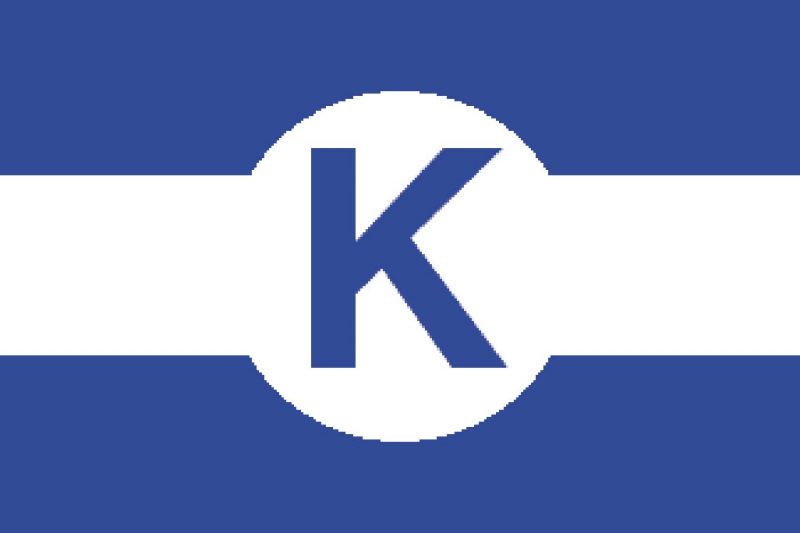 There were two branches of the Klaveness family of shipowners operating in 1946 after the devastation of the family fleet during World War II. Anton Fredrik Klaveness (1903-1981) and his brother Dag Klaveness (1913-1986) operated in the liner, tramping and tanker trades in a family shipowning heritage that dated back to 1799. A luxury cruise ship operation was later set up in 1970 as Royal Viking Line with two other well known Norwegian shipping companies, Bergen Line with much cruising experience, and Nordenfjeldske of the Hurtigruten express service from Bergen to the North Cape.
There were two branches of the Klaveness family of shipowners operating in 1946 after the devastation of the family fleet during World War II. Anton Fredrik Klaveness (1903-1981) and his brother Dag Klaveness (1913-1986) operated in the liner, tramping and tanker trades in a family shipowning heritage that dated back to 1799. A luxury cruise ship operation was later set up in 1970 as Royal Viking Line with two other well known Norwegian shipping companies, Bergen Line with much cruising experience, and Nordenfjeldske of the Hurtigruten express service from Bergen to the North Cape.
A second cousin of the brothers, Torvald Faye Klaveness (1913-1996), had set up a ship management business in 1946 in the bulk trades, principally managing a dozen war standard ‘Liberty’ types, as well as a few years later managing six ore/oil carriers and four cargo-liners. He then built up a very large fleet of self discharging bulk carriers operating in the bauxite trades as Bulkhandling A/S, the first bulker consortium in the world, and which is still operating today with a big fleet of 150 owned, chartered and pooled dry bulkers of up to Panamax and Kamsarmax size.
F. Klaveness & Company Sailing Ships

The dynasty was founded by farmer and forester Thor Aagesson Klaveness (1767-1854) in 1799 in Sandefjord, and he purchased the first brig Ebenetzer a year later jointly with his brother Ole Melsom Klaveness. Unfortunately, this vessel was seized in England in 1907, and he then founded in 1816 a small shipyard to build wooden brigs under the name of Klaveness Verven, which later became the A/S Framnaes Mek Verksted shipyard. He used timber from his own forests to build sixteen small sailing ships including Heldin Anette, some of which were traded by the Klaveness family. After the death of Thor Klaveness in 1854, the yard was run by other family members until it closed in 1861. Two of his sons became shipowners in their own right in Aage Gogstad Klaveness and Thor Bjornum Klaveness. Anton Fredrik Klaveness (1839-1904), the son of Aage Gogstad Klaveness, went to sea at the age of thirteen years and came ashore in 1869 as a Master at Svarstad in Vestfold county to the west of Oslofjord to become a shipowner.
Anton purchased his first sailing ship Victoria of 550 net tons jointly with his brother Wilhelm in 1869, followed in the next ten years by Aurora, Venus, Havfruen, Valkyrien, Brigida, Capella, Staerkodder, Magnat, Elida, Nordpool, Vincitore, and Havfruen (2) of similar size. A large fleet was built up of 35 three and four masted barques with silver grey hulls that were traded from 1869 to 1918 in worldwide trades e.g. guano from South America, timber from Scandinavia to South Africa and Australia returning with wool and grain, copra from the Pacific, rice from Burma and India, and grain and lumber from the west coast ports of Canada and the U.S.A. One of the biggest four masted barques in the fleet was Hafrsfjord of 1,958 grt completed by the Russell yard at Port Glasgow in July 1884 as General Roberts on dimensions of length 275 feet, beam of forty feet, and depth of 24.2 feet. She was purchased in 1905 and photographs exist of her waiting to load grain at Port Lincoln in South Australia on arrival after passages of one hundred days from Christiania (Oslo) and Fredrikstad. She was sold by Klaveness in 1918 and had two further Norwegian owners until she was scrapped at Copenhagen in June 1925.
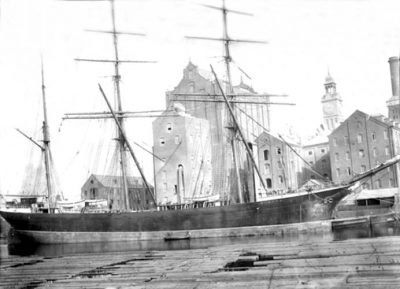
Augusta of 827 grt was a handsome three masted barque completed in 1881 at Framnaes near Sandefjord for the Australian trades. She ran aground and was lost at Mannanzary on Madagascar on 18th September 1901 while on a voyage from Marseille to the island with general cargo and salt. Birtha was a steel three masted barque of 1,425 grt completed by the Russell yard at Port Glasgow in February 1891 for Klaveness. She ran aground on Columbia reef off Nicaragua on 3rd May 1915 while on a voyage from Portland (Oregon) to Falmouth with wheat, eight crew were lost.
Jarlen was a three masted barque of 1,652 grt built in 1874 by T. R. Oswald at Southampton as Foyle for James Nourse of London. She was purchased by Klaveness in 1903 and sailed from Lobos de Tierra in Peru on 16th June 1908 with guano for Antwerp and was never heard from again, twenty crew were lost. Havfruen (2) of 663 grt, completed at Sandefjord in 1880, stranded on the Colbart rocks on 3rd April 1901, and was refloated and towed into Calais and condemned while on a voyage from Drammen to Sydney (NSW) with timber. Senior was a three masted barque of 1,118 grt built in 1885 in Holland and was lost on 23rd August 1913 while entering Maranhao in Brazil at the end of a voyage from Cardiff with coal. Svardstad was a three masted barque of 1,142 grt built in 1885 at Rostock that was wrecked on 22nd September 1909 off Cape Kanin in the White Sea while on a voyage from Archangel to Port Adelaide with timber, one crew member was lost. Svolder was a big four masted barque of 2,015 grt that was completed by Alexander Stephen & Sons Ltd. in May 1887 as Bracadale for J. & A. Roxburgh of Glasgow. She was purchased by Klaveness in 1909 and ran in the Australian trades. She was wrecked on 5th November 1911 off Vinga Lighthouse while on a voyage from Sundsvall to Melbourne with wood.

Despite these losses, the Klaveness sailing ship fleet was profitable and even voyaged to the whaling island of South Georgia with supplies of coal for the Norwegian station of Grytviken and the British station of Stromness. Trafalgar, a three masted barque of 1,501 grt completed by J. E. Scott of Greenock in 1875 was abandoned on fire off Brazil on 25th October 1915 while on a voyage from Liverpool to South Georgia with coal. There were three sailing ships traded by Klaveness during World War I with the advantage of lower operating costs, but this was long after most shipowners had changed over completely to more reliable steamers.
F. Klaveness Steamers
A son of the same name as his father, Anton Fredrik Klaveness (1874-1958), gained experience in the chartering department of H. Clarkson & Company in London, and then worked for a shipping company in Hamburg and for shipowner Anders Jacobsen in Oslo before returning home to Sandefjord in the Spring of 1898. He raised capital from the farming community to pay for new steamers and became a partner in the family firm in 1898, with the name of the company becoming A. F. Klaveness & Company at that time. The first steamship entered the fleet in 1897 as Geysir of 374 grt and built in 1870, followed by two purchased vessels and two newbuildings from the Nylands Verft yard in 1899/1900 as Seirstad and Solstad of 995 grt and 1,500 dwt.
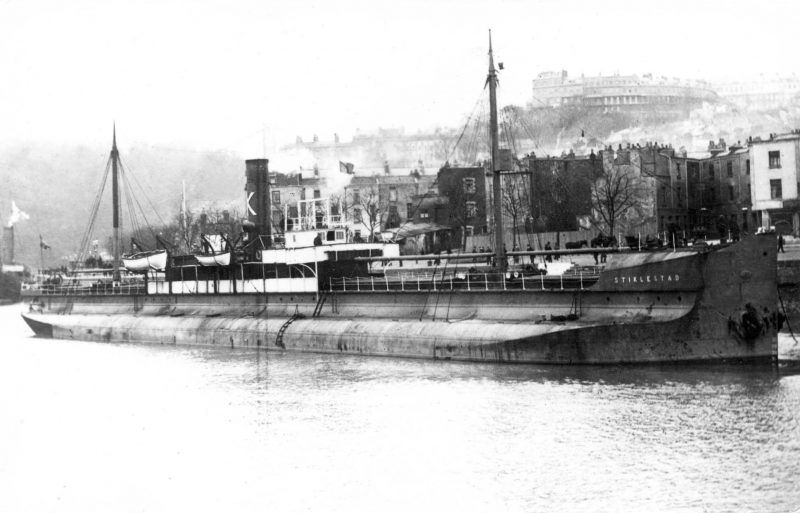
Forest Abbey of 1,777 grt and 3,310 dwt was completed by the Doxford yard in Sunderland in 1895 as a ‘Turret’ ship for a Newcastle shipowner with triple expansion steam engines, and was purchased in 1898 and renamed Stiklestad under the command of Capt. Rastad. She gave ten years of service to Klaveness before sailing from Glasgow for Sydney (CB) with general cargo on 23rd November 1908 and disappeared without trace. General Boyd of 1,375 grt was completed by the Gray yard at Hartlepool in June 1895 with compound steam engines by the Central Marine Engine Works, and was purchased in 1899 and renamed Skramstad, and was damaged in a collision in November 1901. The Head Office of the company was moved to Lysaker just outside Oslo in 1907.
The steamers Vera and Verona of 1,100 dwt were completed in 1903 for four year charters in the West Indian fruit trade under the ownership of A/S International. They continued on renewable charters in this trade until sold in 1932/33. The first ship in the fleet with a ‘ville’ suffix was Mandeville 1,655/11. The latter was also a fruit carrier on long term charter to the United Fruit Corporation of Boston in their ‘mosquito’ fleet of chartered Norwegian ships until she was sold in 1934.
Further tramp steamers in a big fleet of eighteen steamers and three barques in 1914 included the twin hold engines ‘midships Sjostad of 1,800 dwt built in 1908 at Bergen, and Snestad and Steinstad of 4,175 dwt built on the Wear by Robert Thompson in 1907 and 1912, and five tramps of 7,800 dwt in Siljestad from Sunderland Shipbuilding Co. Ltd. in 1912, Skogstad from Robert Thompson at Sunderland in November 1906, Sommerstad from the Gray yard at Hartlepool in 1906, Stigstad from the yard of Robert Stephenson on the Tyne in October 1908, and Wegadesk built in 1908 by Burmeister & Wain at Copenhagen. These bigger tramps were specially constructed for worldwide tramping, as well as the timber trade to the United Kingdom, returning with coal. Sangstad of 1904 from Robert Thompson at Sunderland had been wrecked in the Gulf of Bothnia in the Norra Kvarken area between Finland and Sweden on 3rd October 1909 while on a voyage from Lulea to the Tees with iron ore.
Storstad And The Collision With Empress Of Ireland
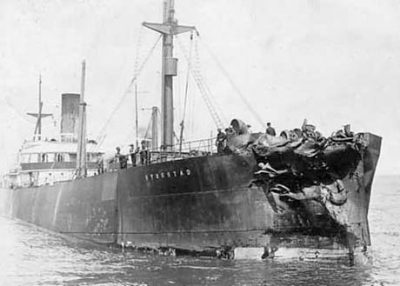
Storstad was a five hold tramp of 6,028 grt that had been completed on the Tyne in 1910 by the Armstrong, Whitworth & Co. Ltd. yard. Empress of Ireland was a twin funnelled liner of 14,189 grt built in 1906 by the Fairfield yard on the Clyde for the Canadian Pacific Railway, and had sailed at 1630 hours on 29th May 1914 from Quebec with 1,477 passengers under the command of Capt. Kendall. In the early hours of the next morning, Storstad was travelling upstream in thick fog off Pointe au Pitre with coal from Sydney (NS) from the Dominion Coal Company on the southern and ‘wrong’ side of the St. Lawrence for vessels moving upstream. The vessels briefly sighted each other, Empress of Ireland stopped and Capt. Kendall put his vessel astern and blew three blasts on his siren. Storstad appeared from the fog and rammed Empress of Ireland ‘midships between the funnels with a mortal hole fourteen feet wide in her hull below the waterline. The liner capsized and sank fourteen minutes later with the loss of 1,012 passengers and crew, many asleep in their bunks. Storstad stayed afloat with severe bow damage and stood by to assist with the rescue before limping into Quebec.
Canadian Pacific Railway (CPR) filed a lawsuit for two million dollars for damages against Klaveness, which did not have the resources to pay, resulting in Storstad being awarded to CPR as recompense. They sold her to the Prudential Trust, an insurance company acting on behalf of Klaveness, for $175,000. Storstad was later torpedoed and sunk on 8th March 1917 when 45 nautical miles south west of the Fastnet by U62 while on a voyage from Buenos Aires to Rotterdam with maize, three members of her crew being unfortunately lost.
F. Klaveness In The Inter-War Years
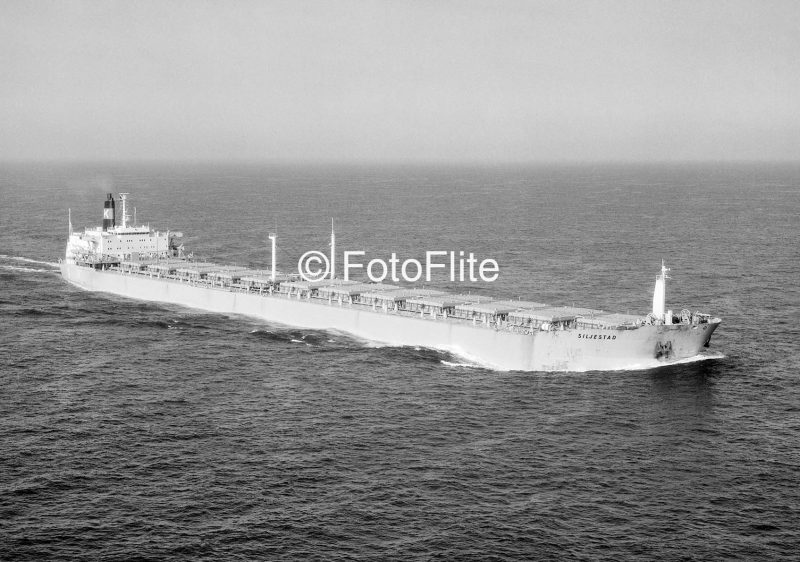
A big fleet of eighteen steamers owned in 1914 on the outbreak of World War I was reduced by war losses to only nine steamers in 1920, with three lost in 1918 – the steam tramp Wegadesk sunk by explosives by U155 to north east of Madeira on 10th March 1918, Siljestad torpedoed and sunk on 26th February by U152 off North Africa while on a voyage from Gibraltar to Montevideo in ballast, and finally Sommerstad torpedoed and sunk by U117 on 12th August 1918 thirty miles south east of Fire Island Lightvessel, New York while on a voyage from Bergen to New York in ballast. Sangstad of 4,175 dwt built in 1911 was sold on to Norwegian owners in 1918 without change of name until she was renamed Dea in 1923 by Brovig of Farsund, and went on to have a long career under the Turkish flag until sold for breaking up at Istanbul in November 1965. The war survivors included Sneppe of 2,100 dwt, built by the Wood, Skinner yard at Gateshead in 1902.
The biggest ships in 1920/21 in the tramping fleet were Stiklestad of 11,285 dwt and Seirstad of 12,825 dwt, completed by yards on the Tyne and on the Wear, with Seirstad having dimensions of length 454.6 feet, moulded beam of 60.3 feet, and depth of 27.9 feet, and both were powered by triple expansion steam engines. Stiklestad was sold in 1928 to Friedrich Krupp A.G. of Bremen and renamed Rheinhausen to carry iron ore to German ports, and Seirstad was lost on 17th May 1933 when she struck an iceberg off Cape St. Francis in Newfoundland and sank the following day while on a voyage from Wabana to Rotterdam with iron ore. They also traded on long term charters with coal cargoes loaded at Sydney (CB), the St. Lawrence river, and Kirkenes in Northern Norway.
Sixty million kroner was spent on new ships of 217,700 dwt in the period from 1924 to 1939. The fleet had been built up to twenty five vessels in 1930, with the liner trades entered in September 1925 with Fearnley & Eger of Oslo as ‘Fern – Ville Lines’ from Mexican and U.S. West Coast ports to the Far East, and ‘Klaveness Line’ in 1929 in the Transpacific, Transatlantic, Far East to Europe, and Oslo to U.S. Gulf ports trades. The Klaveness and Fearnley families were related by marriage, with Dag Klaveness married to Wanda Young Fearnley, and the couple settled into married life at their farm of Nedre Ringi in Baerum, an area to the west of Oslo on the west coast of Oslofjord.
The Klaveness motor cargo-liners had accommodation for a dozen passengers on the liner trades with names ending in the suffix ‘ville’. They included Nansenville of 9,500 dwt from the Kockums yard in 1931, the twin screw sisters Roseville and Granville of 9,265 dwt from the Odense yard in 1930, Stirlingville of 9,215 dwt a Doxford Economy type built in 1935 as Stirling for B. J. Sutherland & Co. Ltd. of Newcastle and purchased a year later, Somerville of 7,840 dwt and the sisters Corneville and Pleasantville of 8,311 dwt from the Burmeister & Wain yard in 1929/30, and the sisters Bonneville and Bronxville of 8,425 dwt from the Odense yard in 1929. The Pacific and Asiatic services continued without interruption throughout the Depression and the late 1930s up to 1940. Roseville, Somerville, Corneville and Pleasantville were the Klaveness motor cargo-liners on these services, loading at Portland (Oregon), San Francisco and Los Angeles for Shanghai, Hong Kong, Singapore, Belawan Deli (Sumatra), the Javanese ports of Batavia, Samarang and Sourabaya, Celebes, Borneo and Philippine ports. Nansenville was sold in 1938 to Royal Holland Lloyd of Holland and renamed Westland for the South American trades.
The new Klaveness motortramps of the inter-war period had names ending in the suffix ‘stad’, Norwegian for town. They included the sisters Skramstad and Sangstad of 7,850 dwt from the Deutsche Werft yard in Hamburg in 1925, the sisters Siljestad and Slemmestad of 7,870 dwt from the Burmeister & Wain yard in 1927/28, and Snestad of 7,710 dwt from the Kockums yard in 1926/27. The Klaveness family had entered the tanker trades in 1916 with Skibs A/S Siljestad and Skibs A/S Solstad. New tankers such as Storstad of 13,460 dwt from the new Blythswood yard on the Clyde in 1926, and Solstad of 8,565 dwt as the first tanker from the new Odense yard in 1927, Stigstad of 8,590 dwt from the Kockums yard in 1927, Sommerstad of 8,670 dwt from the Lindholmen yard in 1926, Seirstad of 14,800 dwt from the Deutsche Werft yard in Hamburg in 1937, and Stiklestad of 14,580 dwt from the Odense yard in 1938. Two new tankers were named after Sir Karl Knudsen and Sir Osborn Holmden, both men served as Chairmen of Clarksons Shipbrokers of London during the period from 1919 and 1945 in a continuing relationship as brokers for Klaveness.
A.F. Klaveness In World War II
A big fleet of 22 ships at the start of World War II on 3rd September 1939 was decimated by the U boat wolf packs with thirteen ships of 105,500 dwt lost, including three in one tragic week in February 1940:-
Snestad torpedoed and sunk on 11.2.1940 by U26 in position 58-40 N 13-40W while on a voyage from Bergen to Philadelphia in ballast, two crew lost, remainder picked up from lifeboat.
Steinstad torpedoed and sunk on 15.2.1940 by U26 when 75 miles west of the Aran Islands in County Clare while on a voyage from Fethiye (Turkey) to Aalvik, 13 crew lost.
Sangstad torpedoed and sunk on 18.2.1940 by U61 in position 59-3 N, 1-8 E while on a voyage from Buenos Aires to Stavanger with grain, Master lost, crew saved.
Skramstad was captured and put under German control in May 1940, becoming a Kriegsmarine auxiliary. She was bombed by U.S. aircraft from carrier U.S.S. Ranger at Bodo on 4.10.1943 and stranded there. She was salved in 1946 and renamed Bertnes under the Norwegian flag and broken up in 1948.
Storstad captured by raider Pinguin on 7.10.1940 while on a voyage from Miri in Borneo to Melbourne with 12,000 tonnes of crude oil. A prize crew was placed onboard with orders to lay a minefield at the entrance to Melbourne harbour. She arrived at Bordeaux on 5.2.1941 and later in the year the vessel and her cargo was confiscated by a Hamburg Prize Court and she was renamed Passat. On 2.9.1942 she was damaged by British aircraft off St. Nazaire and was broken up in the Loire in 1949.
Teddy (tanker) taken as a prize on 8.11.1940 in the Bay of Bengal for refuelling the raider Atlantis, set on fire and sunk six days later in the Indian Ocean with her crew of 32 landed in Japan. Teddy sent off a ‘RRR’ raider signal, forcing Atlantis to leave the area. This tanker had been managed since 1936 for Skibs A/S Golden West, owned by Joh. H. Andresen, and her name interestingly came from a brand of cigarette.
Siljestad torpedoed and sunk on 15.5.1942 by U156 in position 15-20 N, 52-42 W while on a voyage from New York to Table Bay and Alexandria with general and war supplies, two crew lost.
Pleasantville torpedoed and sunk on 8.6.1942 by U135 while on a voyage from New York to Table Bay, Suez and Alexandria in position 34 N, 68 W, 2 crew lost, 45 survivors.
Bronxville torpedoed and sunk by U609 on 31.8.1942 in convoy SC97 in North Atlantic while on a voyage from New York and Halifax to Liverpool with general cargo and explosives, all crew saved.
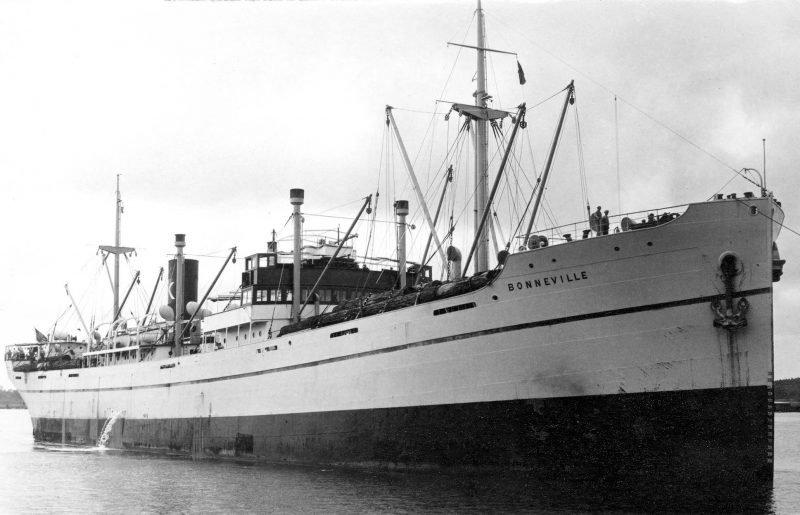
Bonneville torpedoed and sunk on 10.3.1943 by U405 in convoy SC121 in North Atlantic while on a voyage from New York to Liverpool with general cargo, high explosives and invasion barges, 36 crew lost, seven survivors.
Stigstad torpedoed and sunk on 21.2.1943 in North Atlantic while on a voyage from Manchester to New York in ballast, three lost from crew of 37.
Fingal torpedoed and sunk on 5.5.1943 by Japanese submarine I-180 in the Tasman Sea in position 30-35 S, 153 – 29 E while on Admiralty service carrying ammunition from Sydney to Bowen, Thursday Island and Darwin, 12 crew lost, 19 survivors. This engines ‘midships cargo ship of 3,450 dwt had been completed for Rederi A/S Fingal (Lauritz Kloster), Oslo in 1923 and was purchased by A. F. Klaveness shortly after completion.
Corneville torpedoed and sunk on 9.5.1943 by U515 in position 4-50 N, 1-10 W while on a voyage from Calcutta and Table Bay to Takoradi and Liverpool with pig iron, general cargo and tea, all 41 crew saved.
Storstad had given fuel oil to the raider Pinguin, and after minelaying off Melbourne, she met the refuelling tanker Nordmark of the pocket battleship Admiral Scheer in the South Atlantic, and gave most of her remaining fuel oil to Nordmark. Storstad was also carrying many prisoners of war from the British ships sunk by Pinguin, and she then safely evaded Royal Navy patrolling vessels to arrive at Bordeaux.
F. Klaveness In Post-War Years
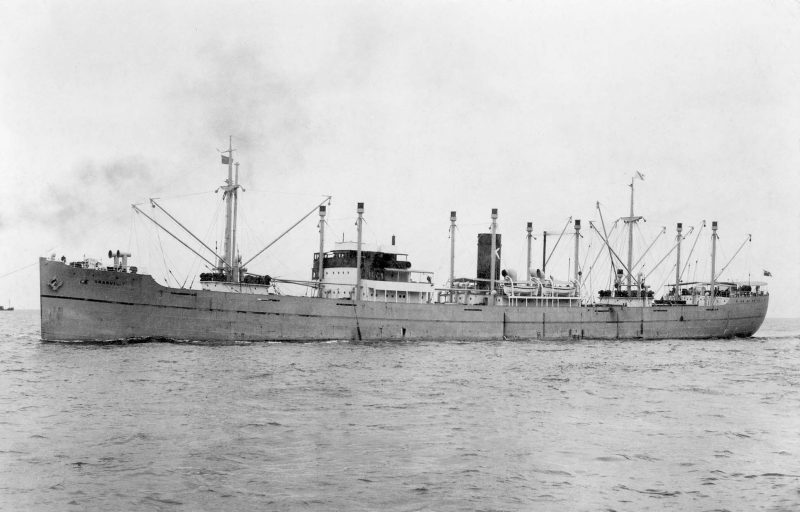
Five cargo-liners and four tankers formed the surviving fleet in 1946. The cargo-liner survivors of Stirlingville, Roseville, and Granville continued on requisition throughout the second half of 1945, with Stirlingville finally returning to Norway in January 1946 for a well earned refit. They had been joined in August 1945 by Hopeville, which was under construction at the Copenhagen yard of Burmeister & Wain in April 1940 when Germany invaded Denmark. She was completed for German war service and was badly damaged on a number of occasions by Allied forces, but was returned to her rightful Klaveness owner as Gotenland 5,315/42 and renamed as Hopeville on 29th August 1945. A sister of Hopeville ordered at the same time from Burmeister & Wain was not so lucky and was a war loss in German hands as Johannisberger.
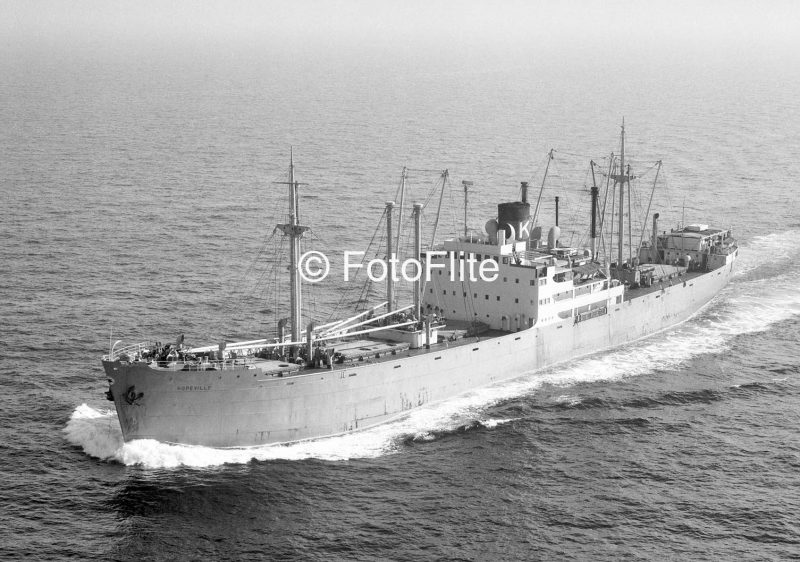
Two ‘Liberty’ ships were purchased in 1946/47 and were renamed as Libreville and Blue Master, the latter managed for Joh. H. Andresen A twin screw cargo-liner of 9,010 dwt building at the Framnaes yard at Sandefjord had been seized by the Germans and was launched in November 1941 as Darss for Norddeutscher Lloyd, and then completed in late 1944. She was found in France at the end of the war, and was returned to her rightful Klaveness owner and renamed Castleville for the Transpacific service from the west coast of Canada and the U.S.A. to Far East ports. She had a split superstructure with a good array of twenty derricks on two masts and six sets of posts, and a service speed of sixteen knots from twin seven stroke Sulzer diesels of 6,650 bhp at 145 rpm.
A newbuilding programme of ten cargo-liners was ordered from the Framnaes yard at Sandefjord, the Eriksberg yard at Gothenburg, Nederland Dock at Amsterdam, Burmeister & Wain at Copenhagen, and the Lithgows yard at Port Glasgow. The latter yard completed Mandeville of 8,780 dwt in 1948 and her sister Glenville in 1950. They had dimensions of length 455.0 feet, moulded beam of 59.5 feet, and depth to weather deck of 27.0 feet, with a fo’c’stle of length 34 feet and a poop of length 43 feet. Mandeville was given oil engines manufactured by the Fairfield yard, whereas Glenville had a seven cylinder Stork diesel manufactured at Hengelo in Holland. They had accommodation for a dozen first class passengers in their split superstructure, part electrically welded hulls with refrigerated capacity in their five holds, and a good outfit of twenty derricks for cargo handling on two masts and five pairs of posts. Belleville, Bougainville, Bronxville, Bonneville, Francisville, Leoville, Pleasantville and Sunnyville were the other cargo-liners of the first replacement programme up to 1950.
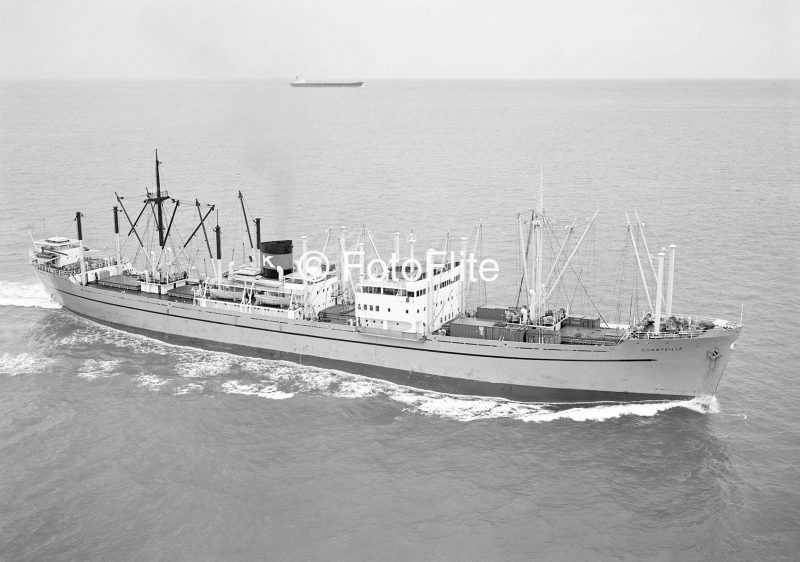
Six of this newbuilding programme operated on the ‘Klaveness Line’ and ‘Fern-Ville Lines’ across the Pacific to Asiatic ports in 1950. Bonneville, Bronxville, Bougainville, Castleville, Francisville and Sunnyville sailed from Vancouver, Seattle, Portland (Oregon), Longview (Washington), San Francisco and Los Angeles to Hong Kong, Manila, Iloilo, Cebu, Singapore, Port Swettenham, Penang, Djarkarta, Sourabaya, Zamboanga, and returned via Manila and Hong Kong to Californian and Canadian west coast ports. The other Klaveness cargo-liners operated a ‘Round the World’ service with Fearnley & Eger cargo-liners from New York, Philadelphia, New Orleans, Houston and calling at the same ports after Panama as the others, but then calling at Singapore, Penang, Colombo, Aden, Port Sudan, Suez, Malta and across the Atlantic to Boston and New York.
The cargo ship Slemmestad, completed in 1928 for the company by Burmeister & Wain and a war survivor, was lost by a fire in her cargo off Dar-es-Salaam on 27th March 1951. She had arrived from Gothenburg with kerosene, asphalt, matches and general cargo and this explosive mixture ignited in the heat of East Africa. The fire burned for ten days and the wreck was then towed out to deep water and sunk. Belleville grounded on 24th September 1957 on Brenton Reef near Newport (Rhode Island) while on a voyage from Singapore to New York, Boston, Philadelphia and Houston with tapioca, rubber, coffee, tea and black pepper. Cargo was discharged into barges for two months until 18th November 1957, but she had broken in two a week before this date, and was then scrapped ‘in situ’.

Ten further new motor cargo-liners and two turbine powered cargo-liners were completed between 1955 and 1963, the total cost of the cargo-liner replacement fleet of 22 post-war ships of 220,000 dwt was 155 million kroner. The turbine powered sisters, Kingsville and Queensville of 10,400 dwt of 1956/57, came from the Lithgows yard with service speeds of seventeen knots from turbines of 10,000 shp manufactured by D. Rowan of Glasgow. Kingsville and Queensville were later lengthened ‘midships at number three hold, and gained a pedestal crane instead of four derricks on two sets of posts. The motor cargo-liners were Somerville of 12,692 dwt from the Deutsche Werft yard in Hamburg in 1956, Oakville of 8,100 dwt from the Eriksberg yard in 1957, Woodville of 12,990 dwt as a closed shelterdecker from Rheinstahl Nordseewerke in Bremen in 1958, sisters Corneville and Libreville of 5,260 dwt and sisters Crestville and Brookville of 6,275 dwt from the Helsingor yard in Denmark during 1955/60, and the sisters Roseville, Granville and Earlville of 9,650 dwt from the Eriksberg yard during 1961/63. The twin screw Roseville dating from 1930 had been sold in 1960 to Olaf Pedersen’s Rederi A/S of Oslo and renamed Sunny Lady to make her name available for the new cargo-liner, and arrived later on 28th April 1971 at Kaohsiung for breaking up as Tyon.
Earlville was launched at the Eriksberg yard on 17th January 1963 and completed six months later, but only made two or three voyages for Klaveness before being sold on 30th December 1963 to A/S Sobral (Oivind Lorentzen, manager of Oslo) and renamed Nopal Rex. Crestville and Brookville, as with all the post-war Klaveness cargo-liners, had accommodation for a dozen passengers, with refrigerated space in her four holds, and fifteen derricks on three masts including a heavy lift derrick. They were sold to Wilhelmsen Line on 20th October 1961 and 23rd July 1963 respectively and renamed Titania and Tema for their West African service.
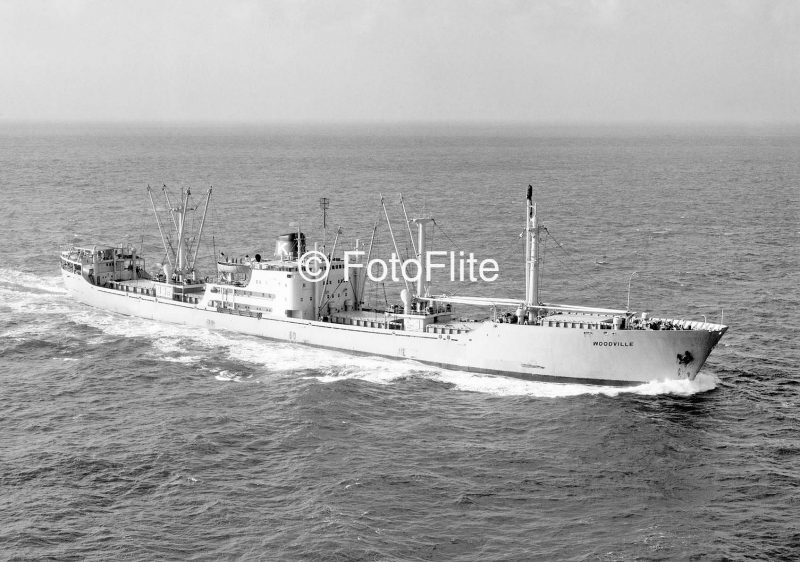
Wilhelmsen had joined with Fearnley & Eger and A. F. Klaveness in 1948 in a close but loose association on the Pacific service to the Far East in ‘Barber Lines’, maintained by a dozen sailings by Wilhelmsen and a dozen sailings jointly by Fearnley & Eger and Klaveness. In 1963, the six Klaveness cargo-liners operating on the Pacific service were Granville, Kingsville, Queensville, Oakville, Roseville and Woodville. Queensville was transferred in 1968 to a joint ‘Fern – Ville Lines’ service from the Far East to U.S. West Coast ports and then via Panama to Venezuelan ports along with five Fearnley & Eger cargo-liners. Finally, in 1969 Wilhelmsen, Fearnley & Eger and Klaveness formally joined together to form Barber Lines A/S, to co-ordinate their Pacific and West African services. This lasted until the first day of 1975 when Fearnley & Eger and Klaveness formally withdrew from the liner trades, allowing Wilhelmsen to purchase their interests and carry on the trades. Kingsville, Queensville and Roseville were the last Klaveness ships to operate in the liner trades.
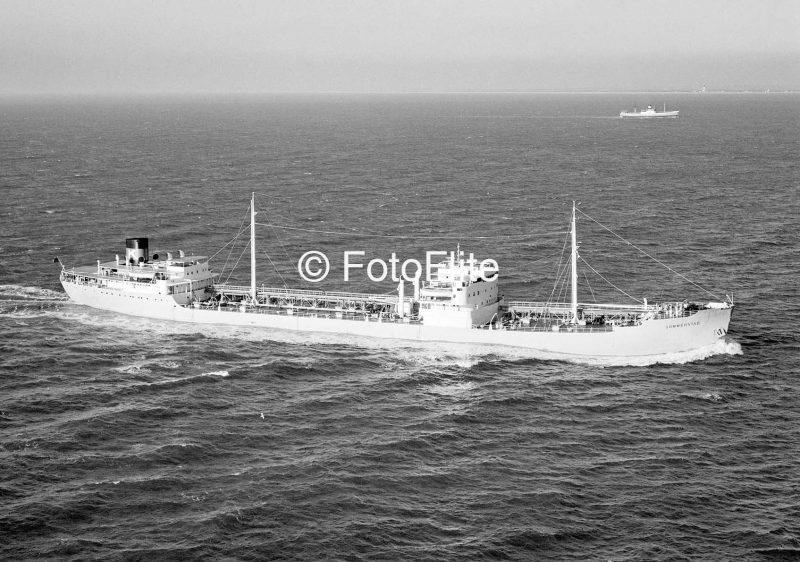
The tanker trades had not been neglected in post-war years, managing the steam tanker Golden West of 7,420 dwt from 1946 to 1948 for Joh. H. Andresen. The tanker Seirstad, completed in 1937 by the Deutsche Werft yard at Hamburg in 1937 for the company and a war survivor, broke in two on 14th January 1958 in a storm while on a loaded voyage from Ras Tanura to Barcelona with fuel oil. The bow section was sunk by a French warship and the aft part was towed to port and sold to Empresa Nacional Elcano of Spain and was then towed to Seville for breaking up, arriving on 4th May 1958. New tankers were built such as Solstad of 14,500 dwt in 1949, Sommerstad of 16,320 dwt in 1950, Sir James Lithgow of 18,200 dwt in 1954 and named as a tribute to the Port Glasgow shipbuilder, Storstad of 33,025 dwt in 1958, Siljestad of 38,000 dwt in 1960, and Stigstad of 19,750 dwt in 1961. Larger tankers and ore/oil carriers were then owned e.g. Siljestad of 151,600 dwt in 1970, and a quartet of sisters of this size in the late 1970s as Solstad, Sommerstad, Siljestad and Sangstad from the Valmet yard in Finland. The parcel tanker Anco Ville of 23,450 dwt was completed in November 1970 by the Eriksberg yard for trading in the ‘Anco’ pool, and was sold in 1973 to Stolt-Nielsen and renamed Stolt Surf. The bulker Sangstad of 35,000 dwt was completed in 1966 and chartered out to the Unibulk pool.

However, the serious slump in tanker freight rates after the OPEC oil price hike of late 1973, later resulted in the bankruptcy of A. F. Klaveness in May 1983. The four remaining tankers of 151,600 dwt were taken over by their Valmet builders in Finland to recover debts on their mortgages. In the same year, the company resigned its membership of the Norwegian Shipowners Association, but a brief revival of shipowning was made in 1989, lasting until between 1992 and 1995 with the tankers Snestad, Steinstad and Sverdstad of 62,600 dwt and Sangstad and Sommerstad of 25,500 dwt. The Lysaker Head Office building was sold off in 1995, and the name of the company lived on in investment and finance companies, which became Klaveness Holdings in 2001.
Anton Fredrik Klaveness, born in Sandefjord in 1903, had died in 1981. He had joined the family firm in 1923, became a director in 1934, and Chairman in 1947. He was a member of the Norwegian Shipowners Association, a director of Norske Shell, Otto Thoreresen Shipping, and Det Norske Veritas. His brother, Dag Klaveness, had joined the family firm in 1939, and became a director in 1947, and was also Chairman of two Norwegian aluminium producing companies, a director of Norwegian America Line, and President of the Norwegian Shipowners Association in 1972, and he died in 1986. They steered the family firm through all of the post-war years, including the setting up of the luxury cruise line, Royal Viking Line.
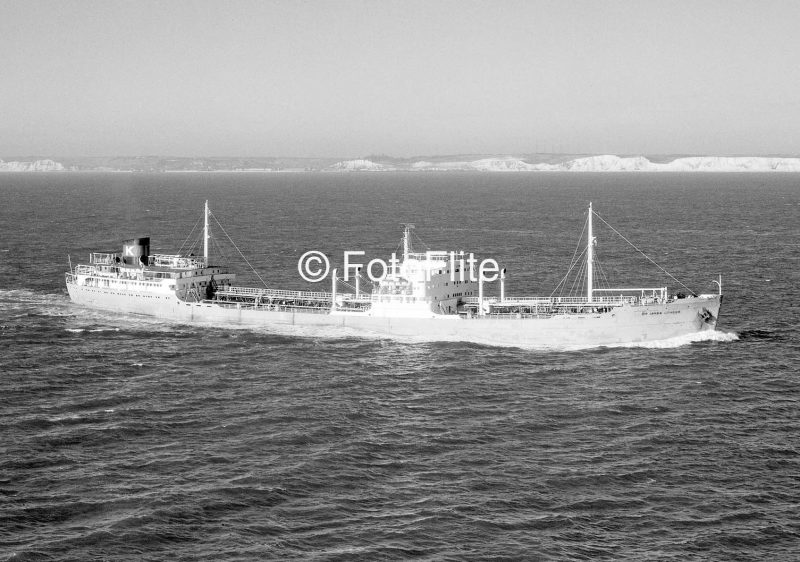
Royal Viking Line
An important luxury cruise line was set up in 1970 by A. F. Klaveness, Bergen Line, a well known passenger liner company with much cruising experience, and Nordenfjeldske, well known on the Hurtigruten express passenger service from Bergen to the North Cape of Norway. Three cruise ships of 21,600 grt with accommodation for 550 passengers, one for each of the partners, were ordered from the Wartsila yard in Finland for delivery during 1972 and 1973. The trio were not designed for the seven day cruising market, but for long range cruising to many and varied destinations including long three month Round the World voyages to take in California, Australia and New Zealand.
Royal Viking Star was delivered first for Bergen Line in 1972, followed by Royal Viking Sea for Klaveness in 1973, and Royal Viking Star for Nordenfjeldske in 1973. The trio were lengthened to 674 feet in 1981 to increase the cruise accommodation to 750 passengers, but by that time Klaveness had withdrawn from the consortium in 1977, with both Bergen Line and Nordenfjeldske selling out in 1984 to the Kloster family. The trio were very well respected in the cruise world, the forward observation lounge being a particularly good feature, and were sold to Cunard Line in 1994 for $170 million. The trio have cruised for well over forty years and are still cruising today as Boudicca (Royal Viking Sky) and Black Watch (Royal Viking Star) for Fred. Olsen and Albatros (Royal Viking Sea) for Phoenix Seereisen of Germany.
Torvald Klaveness
Torvald Faye Klaveness and shipbroker C. Gorrissen established Gorrissen & Klaveness A/S on 27th March 1946, with the stated objective of providing technical management and Norwegian seafarers to American shipowners. This objective was first carried out with the management of a dozen standard ‘Liberty’ types named Aura, Nidardal, Nidarholm, Nidarland, Rana, Sjoa, Sokna, Surna, Tindra, Tista, Trya and Vinstra. Sokna continued under Torvald Klaveness management after C. Gorrissen had withdrawn from the partnership in 1958. The Torvald Klaveness management contract for Sokna also continued after she was converted to a liquefied gas carrier at New York in 1959 for a five year charter to an oil major.
Management of six ore/oil carriers completing at the Govan yard of Fairfield Shipbuilding & Engineering Co. Ltd. from 1952 onwards for shipment of iron ore from Seven Islands on the St. Lawrence was then awarded to Gorrissen & Klaveness A/S. Enduro of 23,870 dwt was completed first in August 1952 with bridge ‘midships and steam turbines DR geared to a single shaft aft. She carried petroleum in bulk in side and bottom tanks, also in forward and ‘midships centre tanks when no dry cargo was carried in adjacent central compartments. She had dimensions of length 638 feet, beam of 80.4 feet and summer draft of 30.7 feet, with part of the special high quality steel of her hull electrically welded. She was also equipped to carry latex in deep tanks, and had the latest navigational equipment on the bridge of direction finders, electric signalling device, gyro compass, radar and radio telephone.
Enduro was followed by her exact sisters Bomi Hills in 1952, Chateaugay in 1954, and Moisie Bay in 1955, with the two remaining ore/oil carriers given hulls five feet deeper to raise their deadweight to 29,060 dwt. This pair had the same hold configuration as their earlier sisters, and was completed in 1956/57 as Cuyahoga and Free State. All of this sextet were regular callers in the Tyne and other British ports with iron ore. Two iron ore carriers were completed in 1958 for Transworld Carriers of Panama by the Eriksberg yard as Cerro Altamira and Cerro Bolivar of 18,934 dwt to carry iron ore from Venezuelan iron ore mines with management by Torvald Klaveness. They had ten hatches to load the iron ore into the holds, with bridge and engines aft, and Cerro Altamira was later converted into the newsprint carrier Trolleggen.
Management of four cargo-liners for charter to Safmarine of South Africa was then entrusted to Gorrissen & Klaveness A/S for Global Marine Transport Ltd., an associate company of States Marine Corporation of New York. Sira of 9,539 grt was completed in 1952 at the Fairfield yard followed by her sisters Simoa in 1953, Sefra and Sjoa in 1954. They were shelterdeckers with dimensions of length 470.2 feet, beam of 62.8 feet, and depth to weather deck of 38.0 feet, a fo’c’stle of length 83 feet, hulls part electrically welded, and a service speed of sixteen knots from two Parsons steam turbines DR geared to a single shaft. This quartet was purchased by Safmarine in 1957/58 and renamed South African Pioneer, South African Transporter, South African Merchant and South African Trader.
Two further very similar vessels were contracted via Global Marine Transport Ltd. and States Marine Corporation for management by Gorrissen & Klaveness and were launched as Sira and Simoa of 9,677 grt by Mitsubishi at Kobe in 1958, but were completed as Cape Agulhas and Cape of Good Hope on charter to and managed by Safmarine. In 1961, they were renamed Surna and Sefra on transfer to Skibs A/S Akersviken under Thorvald Klaveness management. Two similar general cargo ships were completed for A/S Akersviken in 1959 by the Deutsche Werft yard at Hamburg as Simoa and Sira of 15,747 dwt under Torvald Klaveness management, while the bridge ‘midships engines aft ore/oil carrier Sjoa of 32,000 dwt was also completed in 1959 by Mitsubishi at Kobe for Torvald Klaveness management.
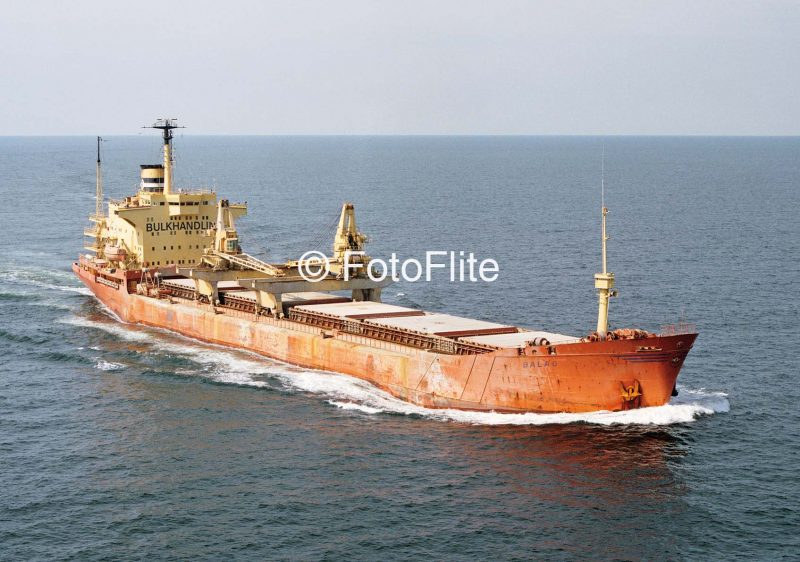
The management and brokerage fees were used to contract an order for the first owned reefer, Balao of 2,167 grt, completed in 1952, followed by Ballenita of 1957, Baleares of 1959, and Balsa and Raft of 1960. Balao had bridge ‘midships, engines aft, with a good array of eight derricks on two goalpost masts, whereas the later quartet were four hold bridge and engines ‘midships reefers of 3,000 dwt. This group began the traditional ‘B’ nomenclature of Torvald Klaveness that is still used today, and were on charter to Geest Line and flew their flag from their navigating masts. The bulk carriers Baumare, Baune and Bauta of 35,380 dwt were completed in 1958 by the Deutsche Werft yard in Hamburg to carry fertiliser from Norwegian ports to worldwide destinations. Two vessels that did not have ‘B’ names were the engines aft coastal bauxite bulker Mosjoen of 2,872 dwt of 1958, equipped with four derricks on two goalpost masts and two electric cranes, and the tanker Mofjell of 12,870 dwt. The latter had been ordered by the Texas Company in 1939 from the Deutsche Werft yard in Hamburg in 1939 and was completed after repair of war damage in 1946 as America for her American owner. She was renamed as Mofjell in 1958 and converted into a bulker at Horten in Norway in 1960 for Torvald Klaveness.
Bulkhandling A/S Pool

In 1960, Torvald Klaveness ordered six self unloading bulkers of 16,500 dwt to operate in the bauxite trade as Bauxite Bulk Carriers A/S in the Bulkhandling A/S pool that was trading in 1963 with partners Gill-Johannessen and Hjalmar Roed of Norway. Gill-Johanessen was an established Norwegian shipowner that had begun in the dry cargo trades in 1915 with A/S Bill, and moved into the tanker trades in the 1930s. The Torvald Klaveness bulkers were Bardu, Bavang, Banak, Bani, Bagru and Bangor, with two sisters completed for Gill-Johanessen and Hjalmar Roed as Beth and Finna. The Bulkhandling A/S pool predated the ‘Star’, ‘Gearbulk’ and ‘Seabridge’ consortia as the first bulker pool in the world.
The bulkers carried bauxite from mines in Jamaica, Ghana and Australia to several aluminium smelters in Norway at Ardal, Hoyanger, Husnes, Karmoy, Lista, Mosjoen and Sunndalsora. Husnes lies to the south of Bergen on the southern shore at the entrance to Hardangerfjord, while Sunndalsora lies in the western fjords at the head of Sunndalsfjord with access from the sea at Kristiansund. Bauxite was also supplied to the British Aluminium Company smelter at Burntisland on the Firth of Forth. The harbour at Burntisland was small, and thus the bauxite was discharged into four barges, cut down from war built North East Coast colliers and renamed as Bulkhandling 1 to Bulkhandling 4. Bulkhandling 5 and Bulkhandling 6 were later especially built in 1978 as newbuilding barges for the bauxite trades. The Burntisland smelter crushed the bauxite into powder and mixed it with caustic soda and heated the mixture under pressure in coal fired autoclave ovens to produce aluminium.
Six self discharging bauxite bulk carriers of 27,300 dwt were then completed during 1971 to 1973 for Torvald Klaveness as Baro, Banta, Bajka, Bakar, Balao and Barwa to a Polish B523 design at Gdynia. This sextet were of the five hold, five open hatch type with two travelling cranes of sixteen tonnes capacity mounted on athwartships gantries. The cranes could travel along the entire length of the holds, and the ships were easily recognisable as Bulkhandling A/S bulkers as this name was written in large black letters on the front of the navigating bridge. The discharging equipment of this group of bulkers was particularly efficient, and enabled Torvald Klaveness to establish partnerships with customers in Africa, South America, Eastern Europe, Asia and Russia.
One customer in Guyana in South America was the Guyana state owned Guybulk Shipping Ltd. and the associated Guyana Bauxite Ltd. and Guyana Timbers Ltd. A powered oil barge of 13,360 dwt was completed at Cadiz in 1981 for an oil supply service to bauxite mining companies on the Mazaruni river. The barge was called Bissaruni, managed by Torvald Klaveness, and the same company was using Torvald Klaveness to manage their bulkers such as Manaka of 22,175 dwt, completed as Fort Walsh for Canadian Pacific Shipping (CPS) at Osaka in 1978, to carry timber, bauxite or other bulk cargoes such as sugar from Demerara to Trinidad. Arrowcane was another Guyana bulker, the former Beth of Bulkhandling A/S.
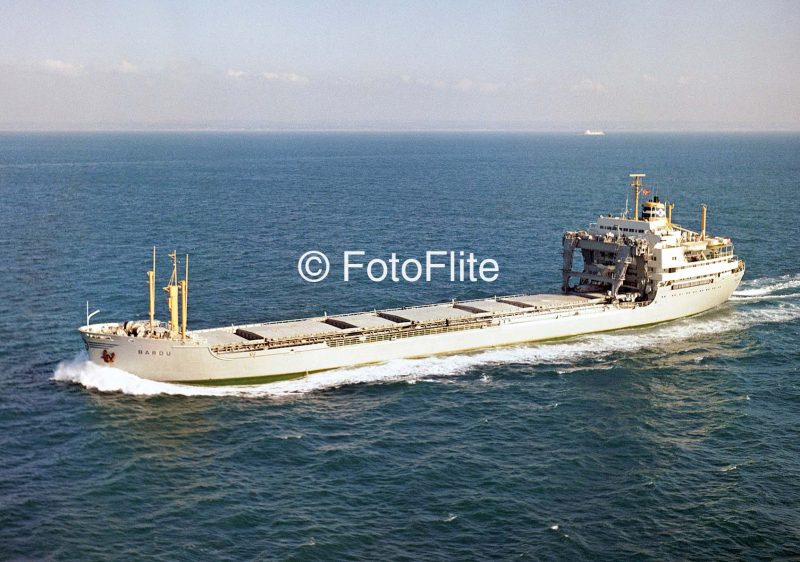
A Panamax bulker, Bantry of 73,866 dwt, had been sold in August 1978 to Cerrahogullari of Turkey and renamed M. Efes after service in the bauxite trades, while the managed bauxite carrier Rio Nunez of 42,245 dwt with seven holds and a summer draft of 38.3 feet was in service from 1976 for Bauxite Carriers Inc after purchase from Olsen & Ugelstad A/S of Oslo as Filefjell until sold in 1979. They were replaced by a trio of bauxite carriers completed in 1978/79 at Gydnia as Bavang, Bardu and Barry of 33,666 dwt. They had seven holds and hatches, were ice strengthened, and equipped with two deck cranes, and had service speeds of 15 knots from a six cylinder Sulzer diesel manufactured at Poznan by H. Cegielski. Two Panamax bulkers of 64,000 dwt were completed in 1981 by the Burmeister & Wain yard at Copenhagen, with one for Eljay Shipping Inc. of Monrovia as Susan B under Torvald Klaveness management, renamed Bandao in 1986, and one for the Baumarine A/S bulker pool as Baumare. They had seven holds and seven hatches and were powered by a five cylinder B & W oil engine of 12,600 bhp to give a service speed of fifteen knots.
The owned fleet in 1995 was a global player in the bulk trades, with two dozen bulkers or ore/oil carriers ranging in size from Handymax to Panamax, Kamsarmax and Capesize bulkers. Most had ‘B’ names such as Ballangen, Baneasa, Banya, Barbosi, Batten, Baumare II, Bauta, Bavang, Blessing, Bobilna, Bujoreni, Baia de Arama, and Baia de Cris. Five Handymax bulkers had been purchased in March 1992 from Russian owners, with another Russian built bulker, Bauchi, sold after fifteen years of service in 1995. Bauchi had been completed at Leningrad in 1980 and was powered by a B & W oil engine manufactured under licence at Bryansk in Russia. A South Korean yard had also built a series of six ore/oil carriers in 1989 for management by Torvald Klaveness. There was also a large time chartered fleet, as well as bulkers from other owners in the Bulkhandling A/S and Baumarine A/S pools.
The founder, Torvald Faye Klaveness, died on 20th May 1996 at Oslo aged 82 years, with his son Tom Erik Klaveness then in charge of the family business. He had joined the company in 1975 and had taken over as Chief Executive Officer in 1989. The fleet he directed was now a global player in the bulk markets and he continued to direct it for another ten years until in 2006 he handed over the responsibility of Chief Executive Officer to his younger brother, Trond Harald Klaveness. In March 2011, a fully formalised agreement of the Torvald Klaveness Group was approved by shareholders to split the group into two separate entities. The investment and real estate activities of the group were taken over by Tom Erik Klaveness and his daughters, while Klaveness Marine was formed to take over the Bulkhandling A/S and Baumarine A/S pools, time chartering of bulkers, self dischargers, belt unloaders and other vessels, all under the direction of Trond Harald Klaveness. The Head Office of Klaveness Marine is in Oslo, with other chartering and manning offices in Shanghai, Constantza, Rio de Janeiro, Singapore and Manila.
In 2002, Torvald Klaveness self discharging bulkers had joined the CSL International pool of Canada Steamship Lines, Egon Oldendorff, and Algoma Central, composed of bulkers working in the Great Lakes (Lakers) and of bulkers in the deep sea trades (Salties). However, the company withdrew their five red hulled self dischargers Barkland, Balder, Baldock, Balto and Balchen from this pool in November 2015. These self dischargers often unload cargo at anchor into barges, which are then towed into shallow depth ports and their final destination at a remote quay. The company continued to supply coal to power stations on the Atlantic coast e.g. to the PNSH Schiller power station at Newington in New Hampshire in gearless bulkers. Coal is in fact the largest commodity carried by the fleet at 30% of all cargoes, iron ore has 27% of all cargoes, grain, oilseeds and sugar has 14% of all cargoes, and bauxite and minor bulks has the remaining 29%. Thus, the Panamax bulker fleet of Bakkedal, Baldock, Banasol, Banastar, Bangor, Baniyas, Bantry and several others with ‘B’ names now spent four months each year carrying coal, e.g. loading coal in South Africa for Genoa, and backloading fertiliser from Genoa to South America before ballasting to South Africa to load more coal.

The current owned fleet in 2017 has a dozen bulkers or combination carriers of Panamax size completed between 2001 and 2007 as Banasol, Barcarena, Banastar, Bangor, Bantry and Bakkedal with six newbuildings completed during 2016/17 with ‘B’ names not allocated at the time of writing. There are also eight container ships named Baro, Barry, Balao, Ballentina, Balsa, Baleares, Bardu and Banak with the ability to carry up to 2,500 TEU of containers. The container ship Bareli, completed in 2003, was declared a constructive total loss at the end of March 2012 after a grounding two miles off Fuqing in China on 15th March.
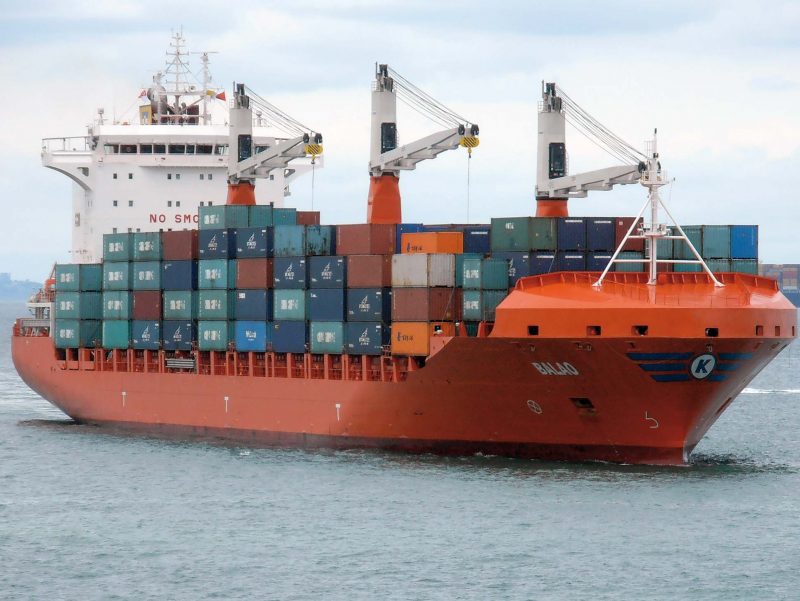
One Kamsarmax bulker is traded as Bavang of 82,000 dwt, and the company also controls Norwegian Car Carriers A/S (NOCC) with a fleet of nine car carriers. Klaveness Marine also has around seventy time chartered vessels at any one time, with another sixty bulkers operated in the two pools. The Head Office in Oslo employs half of the 170 shore staff, with 900 seafarers employed throughout the world, with the entire fleet of owned, time chartered and pooled vessels carrying a huge total of 65 million tonnes of cargo per year.
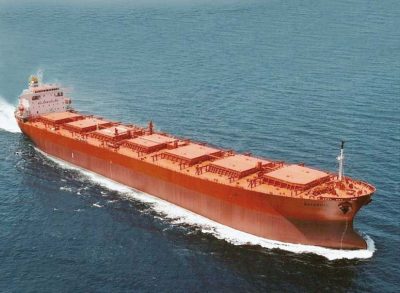
I wish to sincerely thank the excellent website of Klaveness Marine at www.klaveness.com.

Comments
Sorry, comments are closed for this item